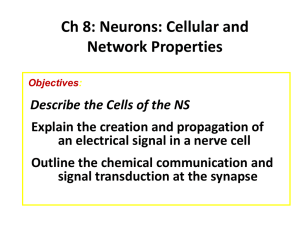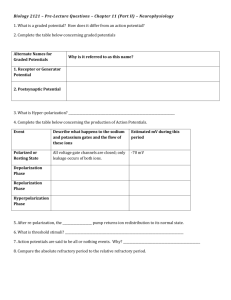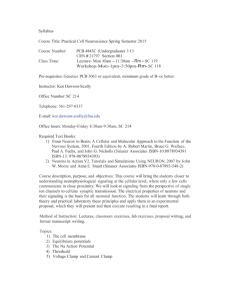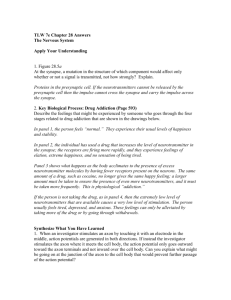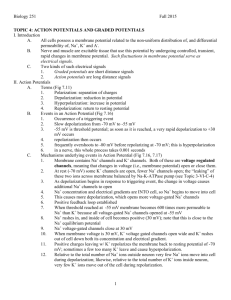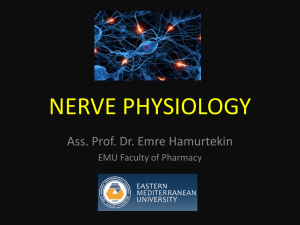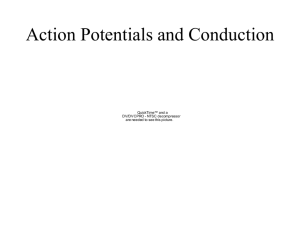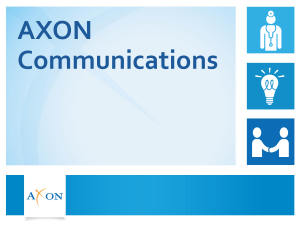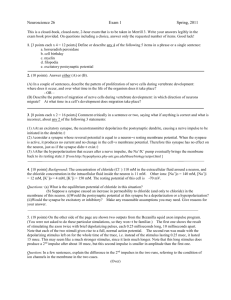Chapter 8: Neurons, Part 2
advertisement
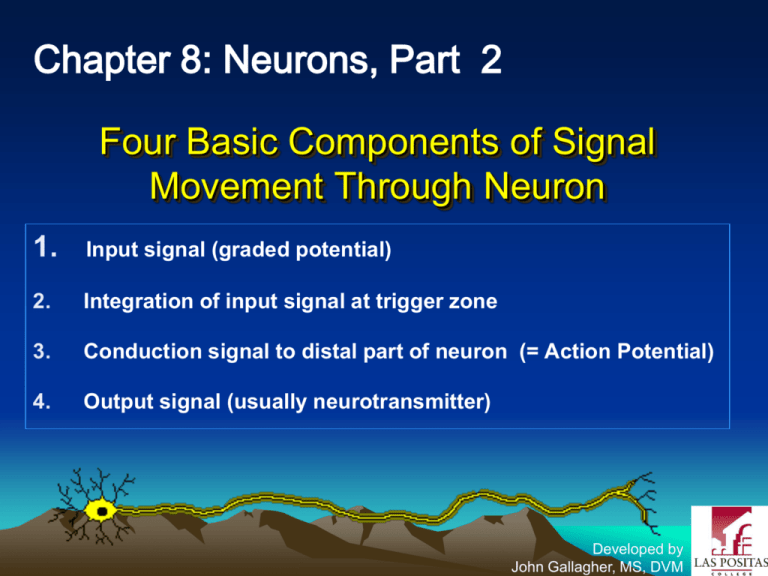
Chapter 8: Neurons, Part 2 Four Basic Components of Signal Movement Through Neuron 1. Input signal (graded potential) 2. Integration of input signal at trigger zone 3. Conduction signal to distal part of neuron (= Action Potential) 4. Output signal (usually neurotransmitter) Developed by John Gallagher, MS, DVM Review of Solute Distribution in Body Fluids •The [ ] gradient of K+ is the main source of the membrane potential •Change in permeability ot Na+ can allow influx of Na+ •Depolarization •Electric signal created •Controlled by gated channels Graded Potentials •Trigger Zone •Usually Axon Hillock •and/or Initial segment of axon •Many Na+ Channels •Some stimuli may be inhibitory •Hyperpolarizing effect Fig 8-7 Graded Potentials Location: Any receptor Strength (= amplitude) ~ strength of triggering event Travel over short distances to trigger zone Amount of local current flow is variable Diminish in strength as they travel May be depolarizing (EPSP) or hyperpolarizing (IPSP) Fig 8-7 Subthreshold potential vs. Suprathreshold potential Graded potential starts here Fig 8-8 AP Conduction Signals: Action Potentials (AP) Location ? Travel over long distances Do not lose strength as they travel Are all identical (all-or-none principle): 100mV amplitude Represent movement of Na+ and K+ across membrane Ability to propagate the AP = Excitability Ion Movement across Cell Membrane During AP Sudden increase in Na+ permeability Na+ enters cell down electrochemical gradient (+ feedback loop for ~ .5 msec) Influx causes depolarization of membrane potential = electrical signal What stops + feedback loop? The Na+ inactivation gate closes. Na+ Channels in Axon Have 2 Gates Activation gate and Inactivation gate Na+ entry based on pos. feedback loop needs intervention to stop Inactivation gates close in delayed response to depolarization stops escalating pos. feedback loop Fig 8-10 AP-Graph has 3 phases 1. Rising (Na+ permeability ) 2. Falling (K + permeability ) 3. “Undershoot” or Hyperpolarization Graded potentials A. Produce an effect that increases with distance from the point of stimulation B. Produce an effect that spreads actively across the entire membrane surface C. May involve either depolarization or hyperpolarization D. Are all-or-none E. All of the above Absolute & Relative Refractory Periods No movement of Na+ possible Na+ channels reset to resting state, K+ channels still open higher than normal Stimulus necessary Fig 8-12 Refractory Periods 1. Limit signal transmission rate (no summation!) 2. Assure one way transmission! 3. Remember that the Na+ and K+ concentration gradients remain nearly unchanged! Animation Forward current excites, backward current does NOT re-excite ! Conduction of AP •Graded Potential •Cytoplasmic flow •AP starts at Axon Hillock •Na+ gates open •Na+ into axon •K+ moves out •Hyperpolarizes membrane briefly •“resets” membrane for next AP Conduction speed depends on . . . . 1. Axon diameter (the larger the faster) 1. Size constraints on axons become problem with increasing organismal complexity Fig 8-17 2. Membrane resistance 1. High resistance of myelin sheath reduces leakage of current (ion) flow between axon and ECF 2. Saltatory Conduction from node to node Fig 8-18 1. Axon Diameter Fig 8-17 Fig. 8-18 2. Signal Transduction in Myelinated Axon: Animation Demyelination diseases (E.g. ?) Output Signal: Communication at Synapses What’s this? Synapse = point where neuron meets target cell (e.g. ?) 2 types chemical electrical 3 components of chemical synapse presynaptic cell synaptic cleft postsynaptic cell Chemical Synapses = Majority of synapses Use neurotransmitters to carry info from cell to cell Axon terminals have mitochondria & synaptic vesicles containing neurotransmitter Events at the Synapse AP reaches axon terminal Voltage-gated Ca2+ channels open Ca2+ entry Ca2+ = Signal for Neurotransmitter Release Exocytosis of neurotransmitter containing vesicles Synapse Fig 8-21 3 Classes of Neurotransmitters (of 7) 1. Acetyl Choline (ACh) – – – – Fig 8-22 Made from Acetyl CoA and choline Synthesized in axon terminal Quickly degraded by ACh-esterase Cholinergic neurons and receptors – Nicotinic (agonistic) and muscarinic (antagonist) 2. Amines – – – – 3. 4. Serotonin (tryptophane) and Histamine (histidine) – SSRI = antidepressants Dopamine and Norepinephrine (tyrosine) Widely used in brain, role in emotional behavior (NE used in ANS) Adrenergic neurons and receptors - and Gases – NO (nitric oxide) and CO Others: AA, (e.g., GABA), lipids, peptides, purines Postsynaptic Responses Can lead to either EPSP or IPSP (p.277) Any one synapse can only be either excitatory or inhibitory Fast synaptic potentials Opening of chemically gated ion channel Rapid & of short duration Slow synaptic potentials Involve G-proteins and 2nd messengers Can open or close channels or change protein composition of neuron Integration of Neural Information Transfer Multiple graded potentials are integrated at axon hillock to evaluate necessity of AP Fig 8-26 1. Spatial Summation: stimuli from different locations are added up 2. Temporal Summation: sequential stimuli added up Fig 8-25 Synapse: most vulnerable step in signal propagation Many disorders of synaptic transmission, e.g.: • Myasthenia gravis (PNS) • • • • Parkinson’s (CNS) Schizophrenia (CNS) Depression (CNS) Many toxins Chapter 9, The CNS • Blood Brain Barrier • Diencephalon (“between-brain”) • Integration of sensory information Blood Brain Barrier • Allows careful selection of what substances can cross to neurons • Capillary walls are different – Fewer pores – Tight junctions – Special carriers • Water soluble substances do not cross easily. – Lipophilic molecules can cross • Vomiting Center in medulla oblongata and posterior pituitary have no BBB. Why?? (p299) Diencephalon (“between-brain”) • Between brainstem and cortex • Thalamus is a relay station – Like spinal cord, can modify information • Hypothalamus is center of maintenance – Autonomic integration and output – RH to anterior pituitary Integration of sensory information • Functional Areas (like compartmentation) – Sensory (becomes perception) – Motor – Association (for integration) • Both brain and spinal cord • Modulation of Output – Reticular formation (p 303) • Group of nuclei in brain stem – State of arousal – Specific NT
